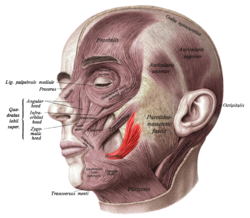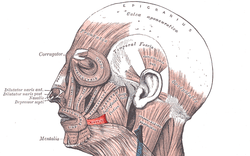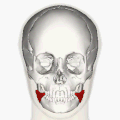Risorius
| Risorius | |
|---|---|
 Superficial muscles of the head and neck, showing the risorius in red. This version of the muscle does not match that shown in most sources. | |
 Muscles of the head, face, and neck. Risorius shown in red. This is the most standard version of the direction and origin of the muscle. | |
| Details | |
| Origin | Parotidfascia |
| Insertion | Modiolus |
| Artery | Facial artery |
| Nerve | Buccal branch of thefacial nerve |
| Actions | Draws back angle ofmouth |
| Identifiers | |
| Latin | musculus risorius |
| TA98 | A04.1.03.028 |
| TA2 | 2078 |
| FMA | 46838 |
| Anatomical terms of muscle | |
Therisorius muscleis a highly variablemuscle of facial expression.It has numerous and very variable origins, and inserts into the angle of the mouth. It receives motor innervation from branches offacial nerve (CN VII).It may be absent or asymmetrical in some people. It pulls the angle of the mouth sidewise, such as during smiling.
Structure
[edit]The risorius muscle is highly variable.[1]
Attachments
[edit]Its peripheral attachments may include (some or all of): theparotid fascia,masseteric fascia,the fascia enveloping the pars modiolaris of theplatysma muscle,fascia overlying themastoid part of temporal bone,and/or thezygomatic arch.[1]
Its apical and subapical (i.e. convergent) attachment is at themodiolus.[1]
Innervation
[edit]The risorius receives motor innervation from thebuccal branchof thefacial nerve (CN VII).[1]
Vasculature
[edit]The risorius receives arterial supply mostly from thesuperior labial artery.[1]
Variation
[edit]The risorius muscle is highly variable. It ranges in form from one or more slender bundles to a wide (yet thin) fan.[1]It may be absent in a significant minority of people, and may beasymmetrical.[2]
Relations
[edit]It is superficial to themasseter muscle,partially overlying it.[3]
Function
[edit]The risorius muscle draws the angle of the mouth lateral-ward.[1]It participates in producing facial expressions like asmile,[4]grin, or laugh.[1]
Clinical significance
[edit]Because it partially overlies the masseter muscle, it may be unintentionally affected during botox injections, resulting in unnatural facial expressions.[3]
Other animals
[edit]It has been suggested that the risorius muscle is only found inHomininae(African great apes andhumans).[5]
Additional images
[edit]-
Position of risorius.
References
[edit]![]() This article incorporates text in thepublic domainfrompage 385of the 20th edition ofGray's Anatomy(1918)
This article incorporates text in thepublic domainfrompage 385of the 20th edition ofGray's Anatomy(1918)
- ^abcdefghStandring, Susan (2020).Gray's Anatomy: The Anatomical Basis of Clinical Practice(42th ed.). New York. p. 626.ISBN978-0-7020-7707-4.OCLC1201341621.
{{cite book}}:CS1 maint: location missing publisher (link) - ^Waller, Bridget M.; Cray, James J.; Burrows, Anne M. (2008). "Selection for universal facial emotion".Emotion.8(3): 435–9.CiteSeerX10.1.1.612.9868.doi:10.1037/1528-3542.8.3.435.PMID18540761.
- ^abBae, Jung-Hee; Choi, Da-Yae; Lee, Jae-Gi; Seo, Kyle K.; Tansatit, Tanvaa; Kim, Hee-Jin (December 2014)."The Risorius Muscle: Anatomic Considerations With Reference to Botulinum Neurotoxin Injection for Masseteric Hypertrophy".Dermatologic Surgery.40(12): 1334–1339.doi:10.1097/DSS.0000000000000223.ISSN1076-0512.PMID25393348.S2CID29325936.
- ^Wilson, P. D. (2014)."Anatomy of Muscle".Reference Module in Biomedical Sciences.Elsevier.doi:10.1016/B978-0-12-801238-3.00250-6.ISBN978-0-12-801238-3.
- ^Page 288 inDiogo, R.; Wood, B. (2011)."Soft-tissue anatomy of the primates: Phylogenetic analyses based on the muscles of the head, neck, pectoral region and upper limb, with notes on the evolution of these muscles".Journal of Anatomy.219(3): 273–359.doi:10.1111/j.1469-7580.2011.01403.x.PMC3171772.PMID21689100.

